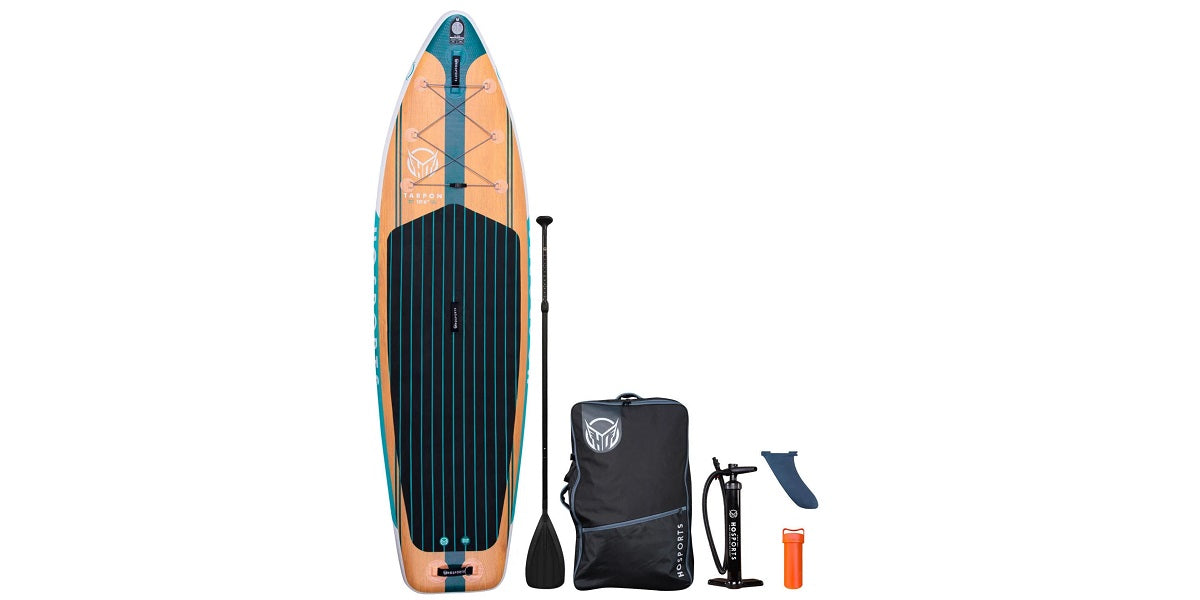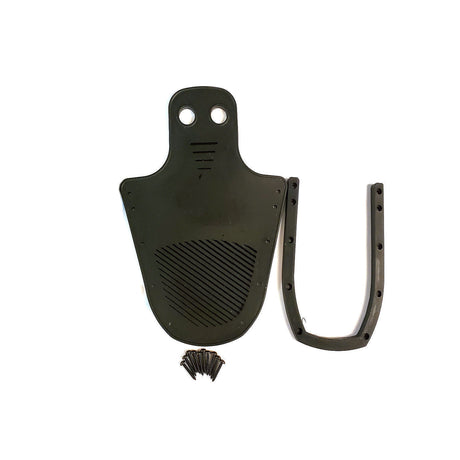The standup paddleboard (SUP) allows you to navigate deep and shallow waters with excellent control. Paddleboarding is an easy-to-learn, relaxing watersport that can be enjoyed by all ages.
Maneuvering with your paddle also affords a great full-body workout, and many enjoy performing yoga on the water atop their paddleboards. Here's how to start paddleboarding for beginners:
Grab a Paddleboard

For beginners, an inflatable standup paddleboard (like the O'Brien Rio, above) is a good choice: They're more affordable and lighter than solid boards, and they're easier to transport and store. When inflated, they provide excellent stability and feel nearly as rigid as a solid board. They're also preferred for paddleboard yoga since they provide a softer surface.
SUP Paddle

SUP paddles are like elongated, single-bladed kayak paddles. The paddle's blade is symmetrical, with a wide teardrop profile. On the opposite end of the paddle is one large T-handle or ball handle for grip. Your SUP paddle should measure about 12" taller than your standing height. A good way to measure for the right paddle length is to raise one arm straight up above your head, with the paddle in front of you. The handle of the paddle should reach your outstretched wrist.
Consider a Paddleboard Combo Kit

A paddleboard combo kit -- like this 10'6" board kit from HO Sports -- comes with everything you need to get started, including a paddle, pump, stabilizer fin, and pack for storing your board when it's deflated.
Board Leash

Although not required, a paddleboard leash is recommended. The leash tethers the board to your ankle via a long elastic cord, preventing the board from drifting away when you fall off.
Life Vest

A standup paddleboard can take you anywhere, including into deep water far from shore. You should always wear a life vest when you're riding your standup paddleboard.
How to Get Started on a Standup Paddleboard

Like most watersports, getting up and moving is the hardest part of paddleboarding. But with a little practice, you'll find it comes naturally. Here's a breakdown of how to get started:
1. Start in shallow water
Although you can mount the paddleboard in deep water, starting in shallow water will make learning to mount the board easier. First place the paddle across the board, toward its front. Stand alongside the board, near its center. The board is widest at its center. If it has carry handles, they'll be near the center, too.
2. Grab the edges of the board and hoist
Reach over the board and grasp both edges of it, then hoist yourself onto the board in a kneeling position. This motion should feel similar to mounting a bicycle. It helps to lean over toward the far edge of the board while getting on; this will help prevent the board from tipping toward you and flipping over.
3. Sit on your knees, and grab the paddle
Before attempting to stand, sit up with both knees resting atop the board. Find your center of gravity, then reach forward and down, and grab the paddle in front of you with both hands. Keep your hands and the paddle planted atop the board.
4. Bring your feet forward, then stand up
While supporting yourself with your hands and the paddle, bring one knee forward and up, planting your foot where that knee was resting.
The next, final step should be made in one, fluid motion: Raise your other knee and bring your next foot forward, transitioning to a temporary squat. At the same time, raise your hands and the paddle up in front of you and proceed to standing upright.
Falling Off The Paddleboard

Chances are high that you'll fall off once or twice while learning to get up on the paddleboard. That's OK! This is, after all, a watersport. If you loose your balance, try to fall to the sides of the board and land in the water. This reduces the chance of crashing onto the board and injuring yourself.
Once Standing, Find Your Balance
Don't lock your knees, and remember to stay loose. Follow these tips to find good balance on the paddleboard:
- Both feet should be parallel to one another.
- Point your toes toward the front of the board.
- Keep your face spaced same the width of your hips.
- Avoid looking down; keep your sight on the horizon.
- Standing in the center of the board, where it's widest.
- Keep your head high and your shoulders upright.
- Keep your knees slightly bent.
How to Hold The SUP Paddle

By following these key steps, you'll achieve good control and effortless speed when paddling on your board.
Forming proper grip
The hand opposite the blade always holds the handle atop the paddle's rod. The hand closest to the blade should be placed roughly halfway between the handle and blade itself, bisecting the length of the paddle, as shown above.
Angle the paddle toward the front
No matter which side of the board you're paddling, the paddle's blade should be angled so the edge that's closest to the board is pointing toward the front. This isn't an exact science, but an angle between 15 and 30 degrees is sufficient.
Keep the paddle vertical and arms straight
The more vertical the paddle is, the straighter your direction of travel will be with each stroke. Keep your arms straight and extended throughout each stroke. Rotate your torso as you pull the paddle through the stroke.
The Forward Stroke
Sweep the paddle in a straight line
To gain speed in a straight line, paddle from the front of the board to its rear while alternating which side you're paddling from. You can switch sides after just one stroke, or you can perform 3 to 4 strokes before switching sides.
This is personal preference, so try both and stick with whichever method feels better to you. Avoid arcing or curving the paddle as you pull it through the water. Maintain a straight front-to-back motion. To turn left with a forward stroke, paddle only on the right side of the board. And, to turn right, paddle on the left side.
Use a 4-foot stroke length
Plunge the paddle's blade into the water two feet in front of you, and pull it back through the water until it's two feet behind you.
The Reverse Stroke
The reverse stroke can be used for slowing down or turning without adding speed through the turn. The reverse stroke requires the exact opposite motion of the forward stroke.
Don't reverse the paddle's angle
Although you're paddling back to front with the reverse stroke, the paddle's blade should still be angled so that the inner edge of the blade is pointed toward the front of the board.
Follow the 4-foot rule
To maintain consistent speed and turn rates, stick with a 4-foot stroke: Sweep the paddle from two feet behind you to two feet ahead. To slow down in a straight line, alternate the stroke on either side of the board.
To turn right, perform the reverse stroke on the right side of the board. To turn left, reverse stroke on the left side of the board.
The Sweep Stroke
The sweep stroke can be used as an alternative to the forward to rear stroke for turning. To sweep, pull the paddle through the water in a wide arc, front to back. You'll need to bend your knees and reach down toward the water, angling the paddle so the rod is about 45 degrees to the water's surface.
Recovering in Deep Water

Once you've up and moving, you're likely to fall off in deep water. First, don't panic. Collect your paddle, and place it atop the board. Then grasp the far ledge of the board with one hand, and float on your stomach and legs. Shimmy back onto the board, get centered, and move back into a seated position on your knees. Then you can find your center of gravity and transition back to standing.
Now that you've learned all the tips and tricks for paddleboarding, it's time to grab your gear. Check out Barts.com selection of paddleboards and hit the water!












